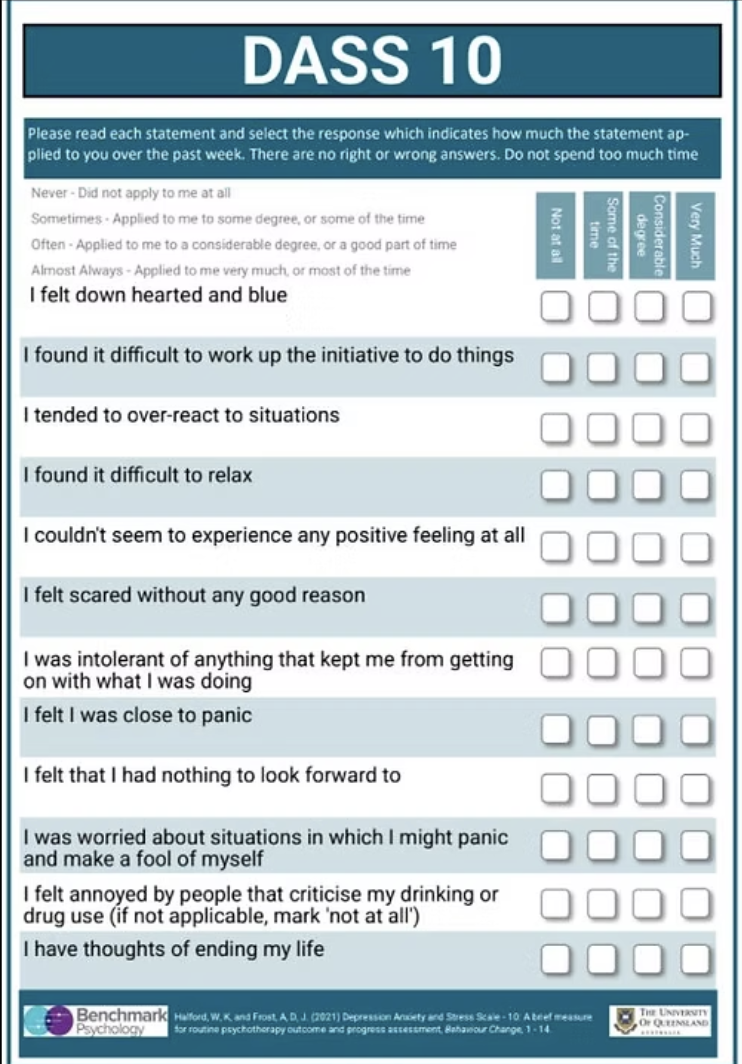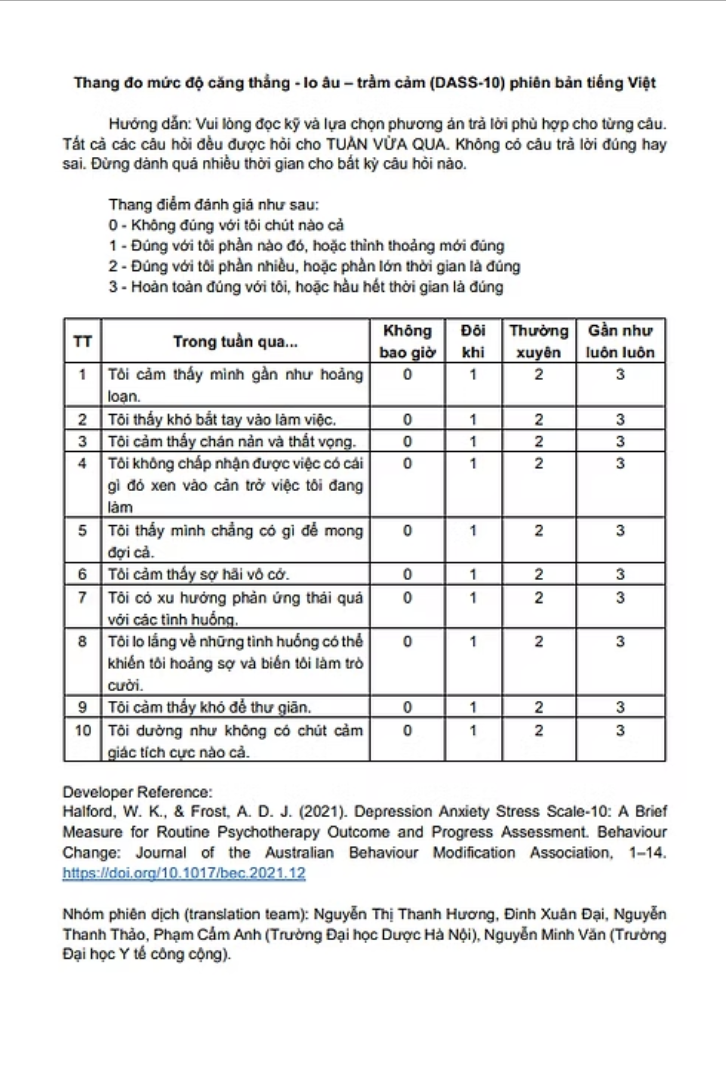
History of the DASS-10
Download the DASS-10 for FREE
DASS-10 (English)

DASS-10 (Urdu)

DASS-10 (Vietnamese)

History of the DASS-10
Building upon the foundation laid by the Lovibonds, Professor Kim Halford and Dr. Aaron Frost developed the DASS-10, an even more streamlined tool intended for routine outcome monitoring in psychotherapy. The DASS-10 consists of 10 items selected from the original DASS, focusing on capturing overall psychological distress rather than delineating between depression, anxiety, and stress
The development process involved rigorous psychometric evaluation across clinical samples totalling over 2,000 individuals. The DASS-10 demonstrated strong reliability and sensitivity to clinical change, making it an effective instrument for tracking client progress in therapeutic settings. Importantly, Halford and Frost have remained true to the legacy of Lovibond and Lovibond and made sure that the DASS-10 is freely available in the public domain, facilitating its widespread use in clinical practice.
Professor Kim Halford
Emeritus Professor W. Kim Halford is a distinguished clinical psychologist renowned for his contributions to couple therapy and relationship education. He earned his PhD in psychology from La Trobe University in 1978 and has since held prominent academic and clinical positions, including Professor of Clinical Psychology at the University of Queensland and Griffith University, as well as Chief Psychologist at the Royal Brisbane
Professor Halford has authored over 190 scholarly works, including influential books such as Marriage and Relationship Education: What Works and How to Provide It and Brief Therapy for Couples. He co-developed the Couple CARE program, an evidence-based relationship education initiative implemented internationally. His research focuses on enhancing couple relationships across various life stages and challenges, including health issues, parenthood, and intercultural
A Fellow of the Australian Psychological Society, the Australian Association for Cognitive and Behaviour Therapy, and the Association for Behavioral and Cognitive Therapies, Professor Halford has been recognized with numerous awards, including the APS President’s Award for Distinguished Contribution to Psychology in Australia. Beyond academia, he has trained over 10,000 professionals worldwide and served as a consultant on marriage and family policy to governments in Australia, Germany, and the United States.
Dr Aaron Frost
Dr Aaron Frost is a clinical psychologist, educator, and national leader in supervision training. He is the Director of Benchmark Psychology in Brisbane and has shaped the training of over 3,000 psychologists across Australia through his leadership of the Supervisor Training and Accreditation Program (STAP). A Fellow of the Australian Psychological Society and 2022 recipient of its Outstanding Supervisor of the Year award, Aaron is widely recognised for his contributions to competency-based supervision and mental health workforce development.
Aaron holds a PhD in Clinical Psychology from Griffith University and has served in leadership roles across academia, professional societies, and the health sector, including as a Non-Executive Director of the APS and advisor to the Productivity Commission’s inquiry into mental health.
He has published in leading journals, advised national mental health reforms, and consulted to organisations including Headspace, Defence, and Lifeline. His public impact includes co-authoring the APS Mental Health White Paper and guiding clinicians during COVID-19 through widely viewed national training.
Known for his engaging teaching style and strategic thinking, Dr Frost’s work bridges clinical practice, policy, and innovation—driven by a commitment to evidence-based care, professional accountability, and meaningful outcomes for clients.
The Evolution of the Depression Anxiety Stress Scales (DASS)
Origins with Lovibond & Lovibond
In the early 1990s, psychologists Syd and Peter Lovibond identified a need for a comprehensive tool to measure the negative emotional states of depression, anxiety, and stress. They developed the original Depression Anxiety Stress Scales (DASS), a 42-item self-report instrument designed to assess these three related but distinct constructs. Each sub-scale —Depression, Anxiety, and Stress—comprised 14 items, carefully selected through factor analysis to ensure they accurately represented each emotional state.
The DASS was grounded in a dimensional approach, emphasising the severity of symptoms rather than categorical diagnoses. Initial validation studies demonstrated strong internal consistency and construct validity, making it a valuable tool for both clinical and research settings.
Development of the DASS-21
Recognizing the need for a more concise instrument, the Lovibonds later introduced the DASS-21, a shortened version containing 21 items—seven per subscale. This version maintained the robust psychometric properties of the original while offering a more efficient assessment suitable for time-constrained environments. The DASS-21 quickly gained widespread adoption due to its brevity and effectiveness.
The DASS was grounded in a dimensional approach, emphasising the severity of symptoms rather than categorical diagnoses. Initial validation studies demonstrated strong internal consistency and construct validity, making it a valuable tool for both clinical and research settings.
Development of the DASS-21
Recognizing the need for a more concise instrument, the Lovibonds later introduced the DASS-21, a shortened version containing 21 items—seven per subscale. This version maintained the robust psychometric properties of the original while offering a more efficient assessment suitable for time-constrained environments. The DASS-21 quickly gained widespread adoption due to its brevity and effectiveness.
Frequently asked questions
Is the DASS 10 as well validated as the original 21 or 42 item version?
The DASS-10 is drawn from the same item pool as the original DASS, it is therefore assumed that the psychometric properties of each item are well understood, and were used to select the relevant items.
The DASS-10 has been tested for construct validity, discriminant validity, sensitivity to change, and internal consistency. It has performed well in these analyses. However it is not fair to say that the DASS-10 has the same proven track record as the original versions. We encourage authors to use the DASS-10 in their work and publish psychometric findings to build the knowledge base around this tool.
How much does it cost to use the DASS-10 in my research / clinical work ?
Free. Professor Halford and Dr Frost are committed to open science, and the implementation of convenient and brief outcome tools in therapy.
Please feel free to use this tool as you see fit, however do not modify it without author permission.
Please feel free to use this tool as you see fit, however do not modify it without author permission.
Can I translate the DASS-10 to a language other than English ?
The fact that researchers and clinicians see value in this tool and are interested in translating it into other languages in both flattering and exciting for our team.
There are currently Urdu and Vietnamese versions that have been produced with permission, and a Malay version is in development by researchers.
There are currently Urdu and Vietnamese versions that have been produced with permission, and a Malay version is in development by researchers.
Please contact us to request permission so we can ensure that only a single version is being developed in your preferred language.
Where can I get support to use measures in my practice?
Supervision is an incredibly valuable resource. Consider searching for a supervisor with expertise in Routine Outcome Measurement through Benchmark Psychology or on Find a Supervisor.
We also have some short courses available below that may be of interest to you.
We also have some short courses available below that may be of interest to you.
